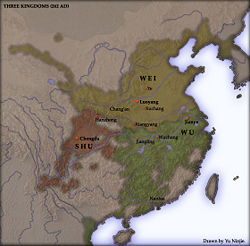Cao Wei
|
|||||||||||||||||||||||||||||||||||||||||

Cao Wei (Chinese: 曹魏; pinyin: Cáo Wèi; Wade-Giles: Ts'ao Wei) was one of the empires that competed for control of China during the Three Kingdoms period. With the capital at Luòyáng, the empire was established by Cao Pi in 220, based upon the foundations that his father Cao Cao laid. Its name came from 213, when Cao Cao's feudal holdings were given the name Wei; historians often add the prefix Cao (from Cao Cao's family name) to distinguish it from the other states in Chinese history also known as Wei, such as the earlier State of Wei during the Warring States Period, and the later Northern Wei state. In 220, when Cao Pi deposed the last emperor of the Eastern Han Dynasty, Wei became the name of the new dynasty he founded, which was seized and controlled by the Sima family in 249, until it was officially overthrown and became the Jin Dynasty in 265.
Contents |
History
During the decline of the Han Dynasty, the northern part of China was under the control of Cao Cao, the Imperial Chancellor to the last Han emperor (see Unification of northern China). In 213, he was titled the "Duke of Wei" and was given ten cities as his domain. This area was named "Wei". At that time, the southern part of China was already divided into two areas controlled by two warlords (later Shu Han and Eastern Wu). In 216, Cao Cao was promoted to "King of Wei".
In March 15 of 220, Cao Cao died and his son Cao Pi succeeded to the title "King of Wei" and the position as Imperial Chancellor. Later that year in December 11, Cao Pi seized the imperial throne and claimed to have founded the Wei Dynasty, but Liu Bei of Shu Han immediately contested his claim to the throne, and Sun Quan of Eastern Wu followed suit in 222.
Wei conquered Shu Han in 263. Shortly afterwards, in 265, the Wei dynasty was overthrown by its own last Imperial Chancellor, Sima Yan, grandson of Sima Yi, who then founded the Jin Dynasty.
Culture
Sometime between the late Eastern Han Dynasty and the Cao Wei, standard or regular script (kaishu) appeared, with its first known master being Zhong Yao[1].
Important figures
- Cao Cao
- Cao Chun
- Cao Fang
- Cao Hong
- Cao Huan
- Cao Mao
- Cao Pi
- Cao Ren
- Cao Rui
- Cao Shuang
- Cao Xiu
- Cao Zhang
- Cao Zhen
- Cao Zhi
- Cheng Yu
- Chen Qun
- Chen Tai
- Deng Ai
- Dian Wei
- Empress Bian (Cao Mao)
- Empress Bian (Yuan)
- Empress Dowager Bian
- Empress Guo Nüwang
- Empress Guo
- Empress Mao
- Empress Wang
- Empress Wenzhao
- Empress Xianmu
- Empress Zhang
- Empress Zhen
- Gao Lan
- Gongsun Yuan
- Guanqiu Jian
- Guo Huai
- Guo Jia
- Hao Zhao
- Jia Xu
- Li Dian
- Man Chong
- Mi Heng
- Pang De
- Sima Shi
- Sima Yan
- Sima Yi
- Sima Zhao
- Wang Lang
- Wang Shuang
- Wen Pin
- Wen Qin
- Wen Yang
- Xiahou Ba
- Xiahou Dun
- Xiahou He
- Xiahou Mao
- Xiahou Shang
- Xiahou Wei
- Xiahou Yuan
- Xu Chu
- Xu Huang
- Xun You
- Xun Yu
- Yang Hu
- Yue Jin
- Yu Jin
- Zhang He
- Zhang Liao
- Zhong Hui
- Zhong Yao
- Zhuge Dan
Sovereigns of Cao Wei
| Posthumous Names | family (in bold) name and first names | Year(s) of Reigns | Era Names and their range of years |
|---|---|---|---|
| Chinese Convention: family and first names, and less commonly "Wèi" + posthumous name + "di" | |||
| Emperor Wen of Wei, ch. 文, py. wén | Cao Pi, ch. 曹丕, py. cáo pī | 220-226 | Huangchu (黃初 huang2 chu1) 220-226 |
| Emperor Ming of Wei, ch. 明 py. míng | Cao Rui, ch. 曹叡, py. cáo rùi | 226-239 | Taihe (太和 tài hé) 227-233 Qinglong (青龍 qīng lóng) 233-237 |
| Shao (少 py. shao4) or King of Qi of Wei, ch. 齊王, py. qí wáng | Cao Fang, ch. 曹芳, py. cáo fāng | 239-254 | Zhengshi (正始 zhèng shĭ) 240-249 Jiaping (嘉平 jīa píng) 249-254 |
| Gaoguixiang Gong of Wei, ch. 高貴鄉公, py. gāo gùi xīang gōng | Cao Mao, ch. 曹髦, py. cáo máo | 254-260 | Zhengyuan (正元 zhèng yúan) 254-256 Ganlu (甘露 gān lù) 256-260 |
| Emperor Yuan of Wei, ch. 元, py. yúan | Cao Huan, ch. 曹奐, py. cáo hùan | 260-265 | Jingyuan (景元 jĭng yúan) 260-264 Xianxi (咸熙 xían xī) 264-265 |
References
- ↑ Qiú Xīguī (2000). Chinese Writing. Translation of 文字學概論 by Mattos and Norman. Early China Special Monograph Series No. 4. Berkeley: The Society for the Study of Early China and the Institute of East Asian Studies, University of California, Berkeley. ISBN 1-55729-071-7; p.142-3
- Bo Yang's edition of Zizhi Tongjian by Sima Guang. 柏楊版資治通鑑
- de Crespigny, Rafe. "To Establish Peace: being the Chronicle of the Later Han dynasty for the years 201 to 220 AD as recorded in Chapters 64 to 69 of the Zizhi tongjian of Sima Guang". Volume 2. Faculty of Asian Studies, The Australian National University, Canberra. 1996. ISBN 0-7315-2526-4.
See also
- Shu Han
- Eastern Wu
- Three Kingdoms
- Personages of the Three Kingdoms
- Timeline of the Three Kingdoms period
- Romance of the Three Kingdoms
- Records of Three Kingdoms
- Dynasty Warriors
